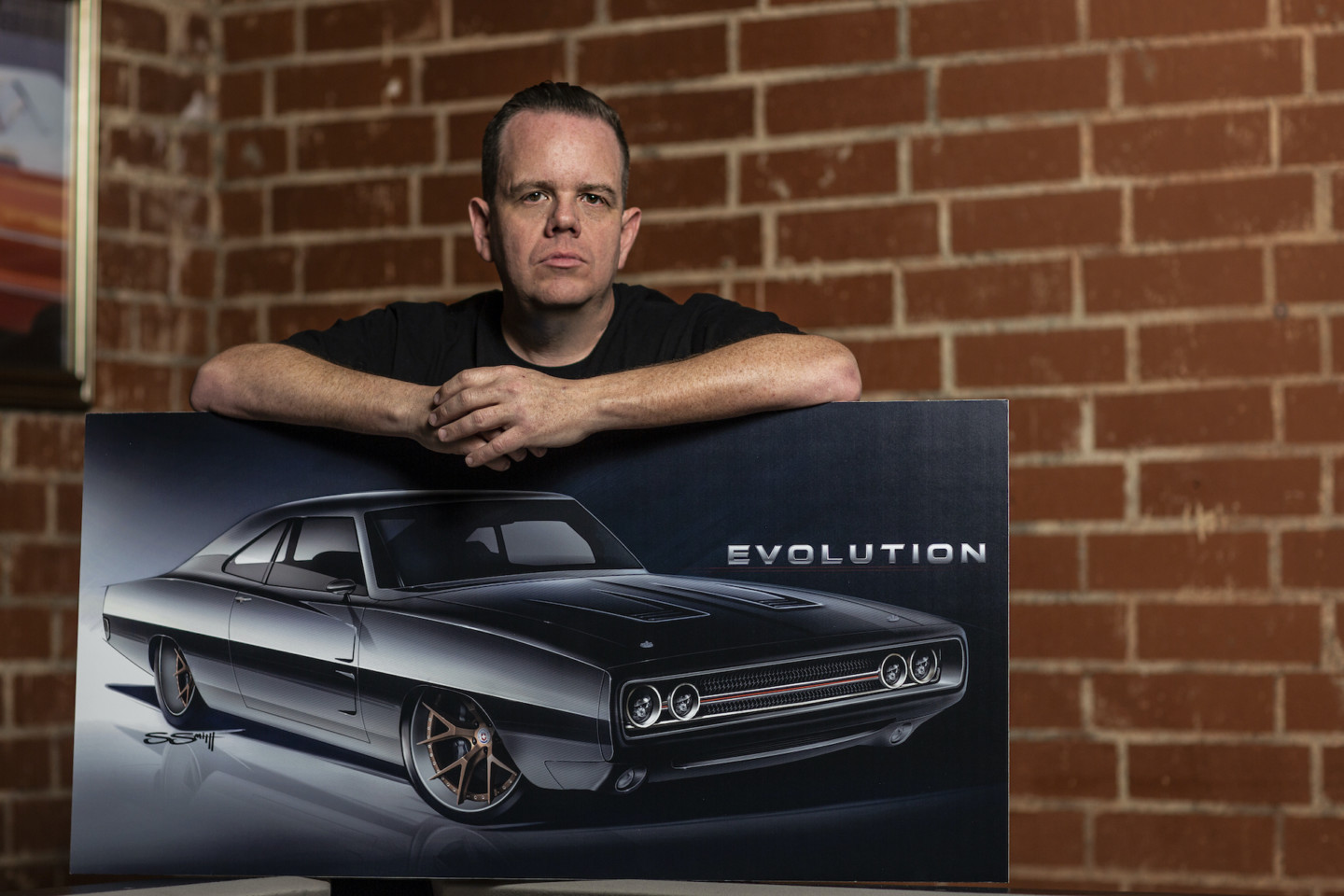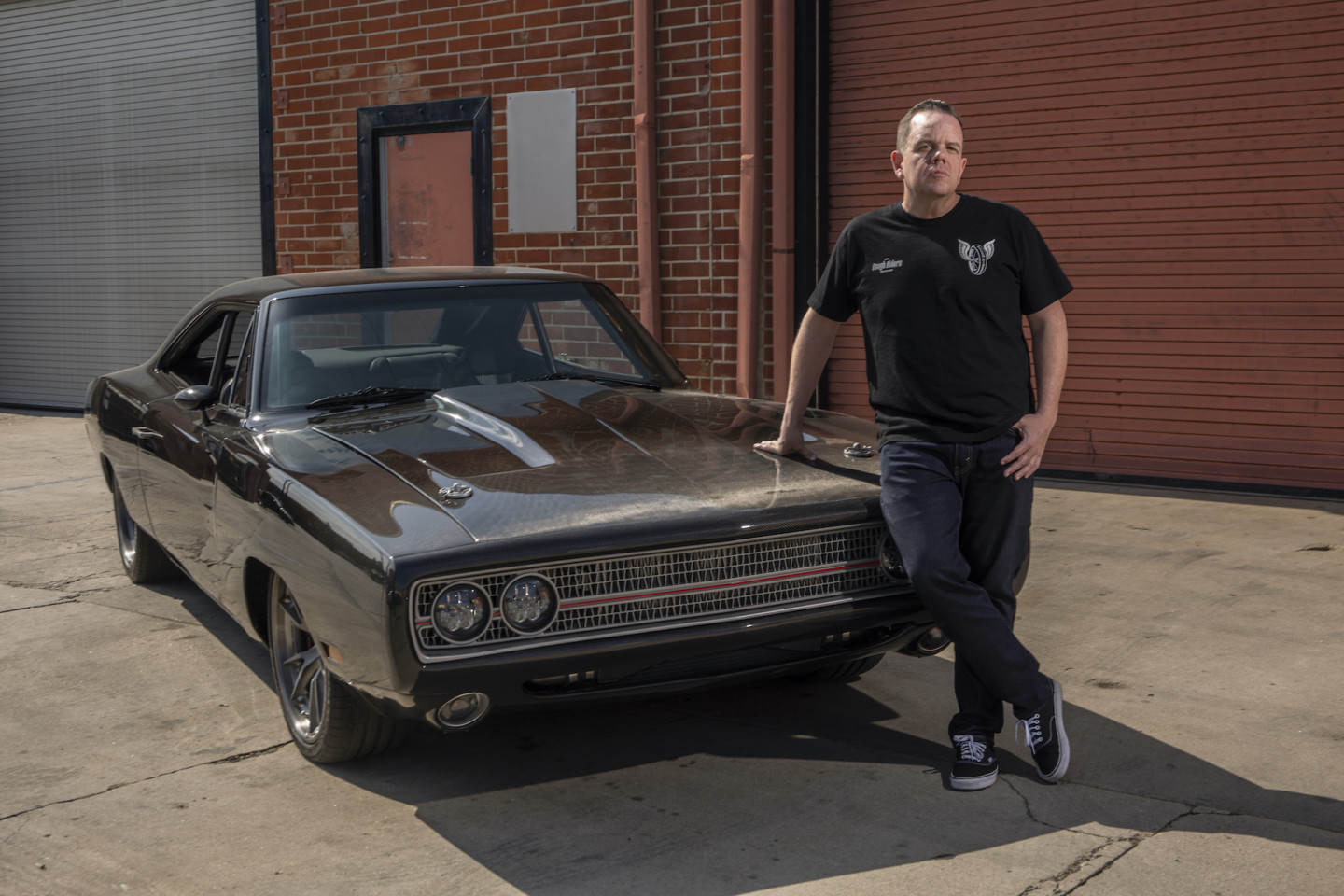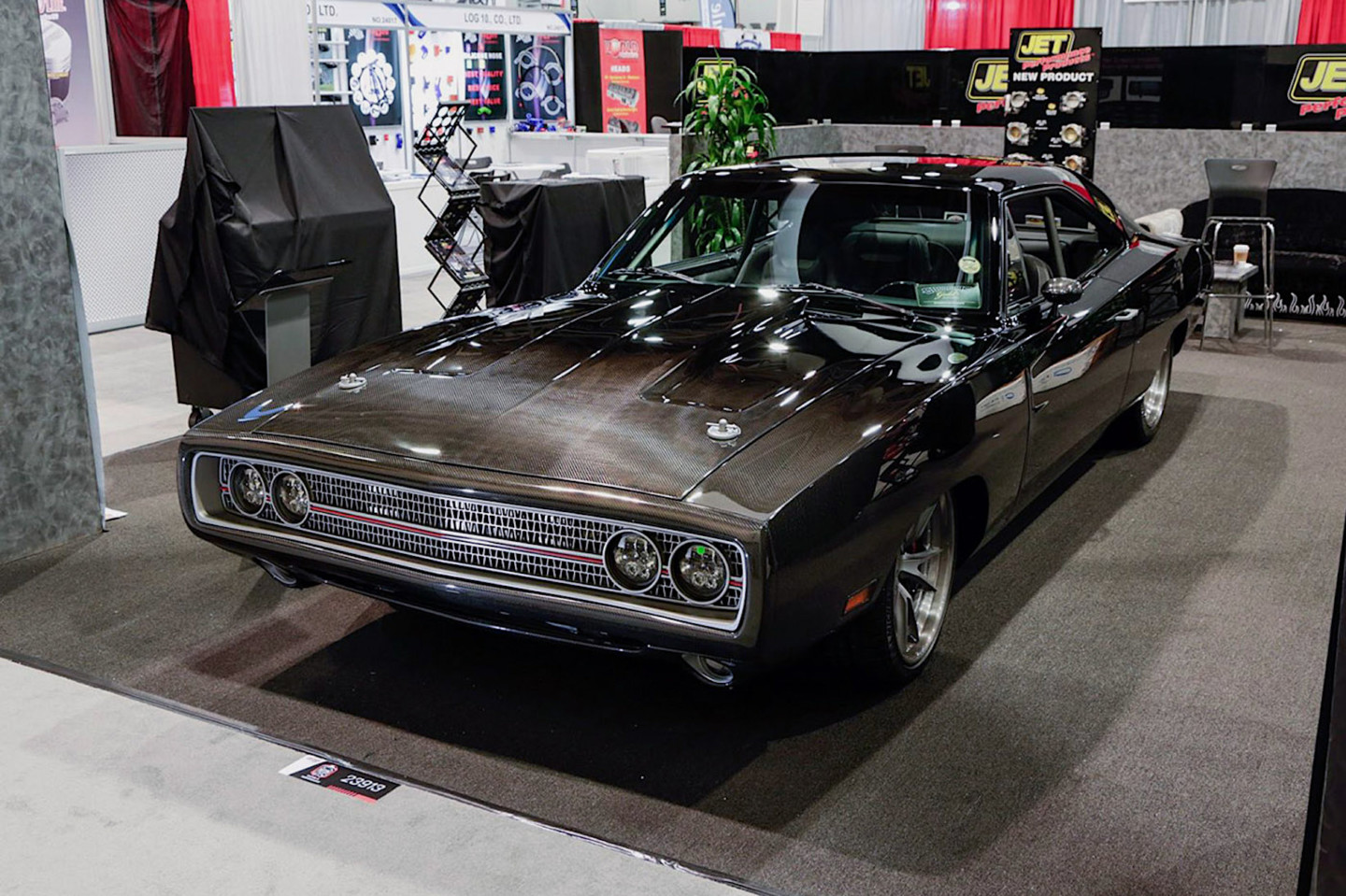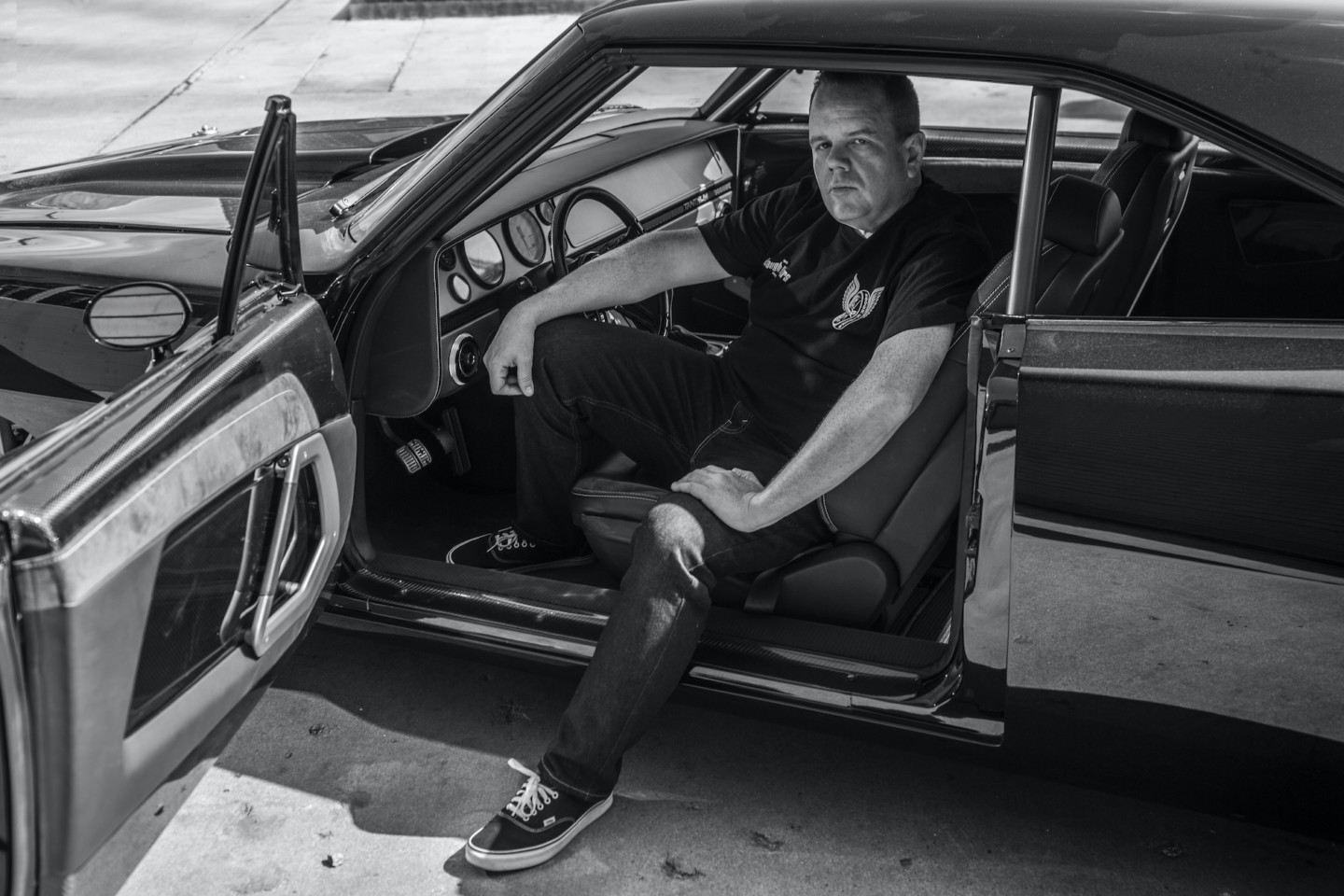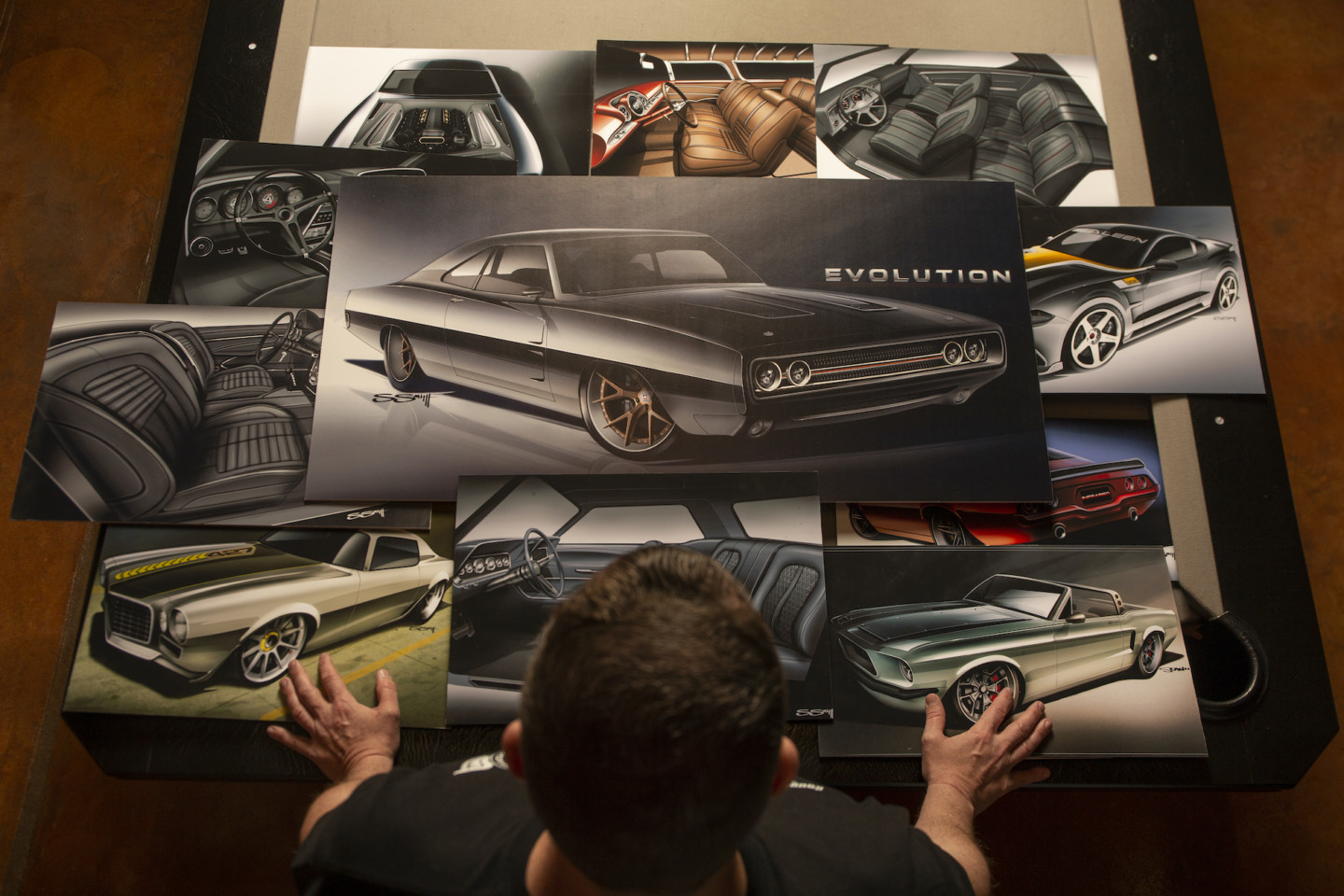In the roughly 60-year history of American muscle car design, there are a handful of people who rightfully belong in the pantheon of all-time greats. John DeLorean, Larry Shinoda, John E. Herlitz, and Zora Arkus-Duntov are just a few who immediately spring to mind.
Today, though, there is a bold new generation pushing the outside of the envelope in automotive design when it comes to aesthetics, ingenuity, and unabashed audacity. One of these latter-day masters of muscle car conceptualization is responsible for some of the most outrageous beasts ever to hit the streets and drag strips. While you’ve probably seen a number of his creations, it’s entirely possible you don’t know his name.
Well, that ends now, as Sean Smith is someone you most definitely should know.
The Early Years
Sean was born into a solidly middle-class family in 1978 in San Bernardino, California. His father was an auto mechanic who specialized in building motors and tearing up the tarmac around town, while street racing and cruising E Street. Likewise, his mother’s side of the family had a connection to automobiles, as Sean’s maternal grandfather owned a shop he established in 1948.
Sean’s father ultimately bought his father-in-law’s shop. From an early age, Sean would hang around the place and help out during summers and school vacations. His father taught him some mechanical skills but always had bigger plans for him than to carry on in the physically taxing auto repair business. Ideally, he wanted to see Sean go to college, something he didn’t have the chance to enjoy himself.
Sean, nonetheless, continued to work at the shop throughout high school.
“It was 12 hours a day of hard work during the hot desert summers, but looking back on it, I’m glad I was in that environment. Being around that blue-collar ethic instilled in me a sense of how important hard work is. That informs my decision making and approach to things today,” Sean reflects.
During his adolescent and teen years, Sean developed a well-above-average ability to draw. It’s no surprise, given his background, that cars were often the subject of his sketches.
“I liked to invent cars that didn’t exist in my drawings, such as concept hot rods. I’d take a ’33 Ford, for example, and redesign it all slick.”
Talent Recognized
So undeniable was Sean’s talent, that a teacher sent some of his product sketches for sneakers to Nike. A few months later, Phil Knight, co-founder of the company, sent Sean a handwritten letter lauding the young man for his talent and a keen eye. It was a seminal moment for Sean and one that convinced him that he belonged in the field of industrial product design.
Seeing Sean’s enthusiasm ignited, the teacher secured him an interview at the illustrious Art Center College of Design in Pasadena. Though he was still a sophomore, the hope was that he could receive advanced placement in the school.

An early 1/4-scale model of a hotrod concept Sean created at the Art Center College of Design. (Photo: Sean Smith)
“I remember walking in, and the first thing I saw was a project sponsored by Hot Rods by Boyd’s consisting of these concept street rods. They were just like my old drawings! I had gone there with the idea of designing shoes, but it suddenly hit me that I could learn to design cars.”
Since the student body consisted mostly of 30-year-olds who had already graduated from a college or university, Sean was deemed too young to enroll in the college. He was, however, allowed into the Saturday High program.
“It was a car design program for high school students, taught by professional instructors,” recalls Sean. “I was going to high school during the week and Saturday High on the weekends. I attended it for the next three years and built my portfolio up.”
Learning The Craft
Upon graduating high school, Sean began freelance designing for the automotive aftermarket scene. VW Magazine approached Sean to do a series of renderings on how the new Beetle would look customized. Sean used it, along with his burgeoning portfolio, to reapply to Art Center College of Design, and was finally accepted.
The school was a rigorous experience, but one that Sean thrived in. Many of his professors were amongst the biggest names in automobile design, including Ken Okuyama, who designed the Ferraris and Maseratis of the early-2000s, and Dave Marek, the design director at Acura.
Applying His Skills
Sean left the Art Center with a Bachelor of Science degree and set out on a career in vehicle design. His first stop was Honda in Torrance, California, designing motorcycles, of all things.
“I didn’t know a thing about bikes — never learned to ride one. I think Honda felt that since I was a hot rodder, that somehow this would work well with the mindset they had,” Sean postulates.
At Honda, Sean found himself working on some of the choicest projects, including the CBR1000, CBR600, and the Honda Chopper, to name a few.
“Designing bikes was way harder than designing cars. With a bike, you have a lot less real estate to work with. You’re not designing one big shape that everything fits in, you’re designing different shapes that all surround an engine, and each has to work in harmony with the human anatomy.”
When a design is executed exactly the way I envisioned it through a great team, and the customer is happy, that’s as good as it gets. — Sean Smith
Despite enjoying the projects he was working on, Sean wasn’t entirely happy there.
“I liked working at Honda, but some of the management was more corporate than what I was used to. I was young, a bit of a knucklehead, and probably could have had a more adaptive attitude. But at the time, I felt it wasn’t the place for me, so I left.”
A Chance Meeting And A Rough Road
A chance meeting with Mike and Jim Ring at SEMA in 2004 led to his next career stop, designing cars and billet accessories for their startup, Ringbrothers.
“I worked for them part-time, flying out to Wisconsin several times a year. We started doing all of that industrial-looking stuff together, exposed bolts, the Bauhaus thing. It was great, as the aesthetic I learned at Honda was exactly what they were into, too.”
A series of notable one-off restomods resulted, including the Ringbrothers’ 1967 Reactor Mustang, the 1969 Razor Camaro, and the ’65 Producer Mustang. Together, Sean and the Rings set a new look for custom cars, and other builders began to follow their lead.
At the same time, Sean took an unusual full-time job, designing virtual cars for video games at Rockstar in San Diego.
“I rendered cars and body kits for Grand Theft Auto, Midnight Club, and others. It was a really cool gig, and I continued moonlighting for Ringbrothers. I was making stupid money for a 26-year-old and loved the work. I did that for four years until Midnight Club was canceled, and I was laid off.”

Sean and the Ring brothers with Edsel Ford II after winning the Ford Design Award at SEMA 2012 for their concept Ford Mustang. (Photo: Sean Smith)
This coincided with the financial crisis of 2008, and Sean was unable to find employment.
“Those were dark years,” Sean remembers. “Nothing was going on in the world of cars, and no one was hiring. It really leveled my hotshot attitude.”
The Big Breaks
Sporadic freelance jobs aside, he was largely out of work until 2012 when he moved to Wisconsin to work with Ringbrothers. A concept version of the facelifted 2012 Mustang for Ford and a ’65 Mustang widebody resulted.
“Best of all, living in Wisconsin really grounded me again. It helped me hit the reset button in terms of my humility. I had been living kind of fast in San Diego.”
Sean and the Rings took the 2012 concept Mustang to SEMA. There, Sean met Steve Saleen, who offered him a full-time job on the spot. Sean was ready to move back to California and eager to work for an outfit like Saleen, so he accepted.
“I felt resurrected after four long, lean years,” Sean asserts.

Sean’s sketch for the George Follmer Saleen Mustang. (Image: Sean Smith and Saleen Automotive, Inc.)
He designed the limited-edition George Follmer Mustang, based on Follmer’s original race car from back in the day, replete with the classic red and black paint scheme. The car debuted at the Pebble Beach Concours d’Elegance in 2013. He also worked on a Saleen/Tesla concept that likewise made an appearance at the prestigious show, as well as the Saleen S550 Mustang, and Saleen S7 hypercar.
Sean stayed at Saleen for four years, but the ebb and flow of the industry saw the company hit a slow patch, and Sean departed, looking for something new.
A Bold New Venture
That fresh pasture would be a bold new venture, SpeedKore Performance Group.
“I came in at the start. The company didn’t even have a name yet. We came up with a few ideas such as 1320, Kinetic Motorsports, and so forth, but we settled on SpeedKore as it combined ‘speed,’ which was the goal, and ‘kore,’ suggesting a collective of like-minded car nuts. The three-spoke logo represented the three facets of the company: design, engineering, and manufacturing.”
Together with David Salvaggio and Jim Kacmarcik, Sean set out to make SpeedKore the preeminent, specialty, low-volume, high-end muscle car manufacturer brand.
“We needed to make a statement of intent from the start. And, that ended up being a 1970 Dodge Charger that we named ‘Tantrum.'”
Tantrum featured a monster 1,650-horsepower Mercury Marine 9.0-liter, twin-turbocharged V8 mated to a Tremec T56 six-speed. It was built on a custom-fabricated chassis and wore carbon fiber bodywork from the firewall forward. A unique fade-to-black paint job left the carbon parts exposed. Custom machined aluminum parts, LED lights, a leather and Alcantara interior, HRE wheels, Baer brakes, and 345-series Michelin tires completed the package.
Tantrum debuted at SEMA in 2015, and the reaction was massive. Articles about it proliferated. Tantrum was featured on Jay Leno’s Garage, and the awards flowed in.
“People lost their minds over it. It set the tone for the brand, which was what was most important to us. I always say that you don’t just build the car; you build the brand,” Sean notes. “It’s not just sneakers or cars or sunglasses. A brand is what something makes you feel when you attain it or use it. People don’t buy Louis Vuitton because they need a friggin’ handbag, they buy it because it gives them a feeling. The same is true for Apple computers or Ferraris. That’s what we wanted to achieve with SpeedKore.”
Achieve it they did. Since Tantrum, a stream of ever-more-monstrous cars flowed from the company: a 1967 “Captain America” Camaro for actor Chris Evans; a 1970 Ford Mustang Boss 302 for Robert Downey Jr.; a full-carbon 1970 Dodge “Evolution” Charger; a full-carbon, twin-turbocharged 2018 Dodge Demon; and the 1970 “Menace” Barracuda. SpeedKore also diversified with a line of parts and merchandise, befitting any top brand.
Building His Brand
Sean was very proud and personally satisfied with what was achieved in only a few short years at SpeedKore. However, some personal matters and a desire to stay in California instead of moving to Wisconsin again to be a full-time SpeedKore team member, led him to leave the outfit.
These days, Sean is focused on his own company, a design consultancy firm simply called Sean Smith Design. Through this venture, he still works with SpeedKore, Saleen, and a host of other automotive builders, but he has added marine and product design to his repertoire.
“I did the Grimm 7.0 Camaro for Lopez Customs, a ’67 Chevelle for American Legends Hot Rods and Muscle Cars, and a ’69 Fastback for Cambra Speed Shop. I’ve got a lot of things on the front burners right now, which I, unfortunately, can’t discuss at this point. There are quite a few projects you’ll be hearing about in the near future, though.”
He’s currently building up his company, and of course, building up his brand. Looking back on a life centered around cars and design, Sean is philosophical.
“Yeah, giving a customer a finished build that they’ve always dreamed of is terrific, sure. But, I think being able to work with a team of great people who all understand the process of design and respect that process is really special. When all the egos are checked at the door, and everybody works towards one goal, that’s my thing. When a design is executed exactly the way I envisioned it through a great team, and the customer is happy, that’s as good as it gets.”
I, for one, have no doubt that Sean will continue to make a lot of customers happy. Very, very happy.




